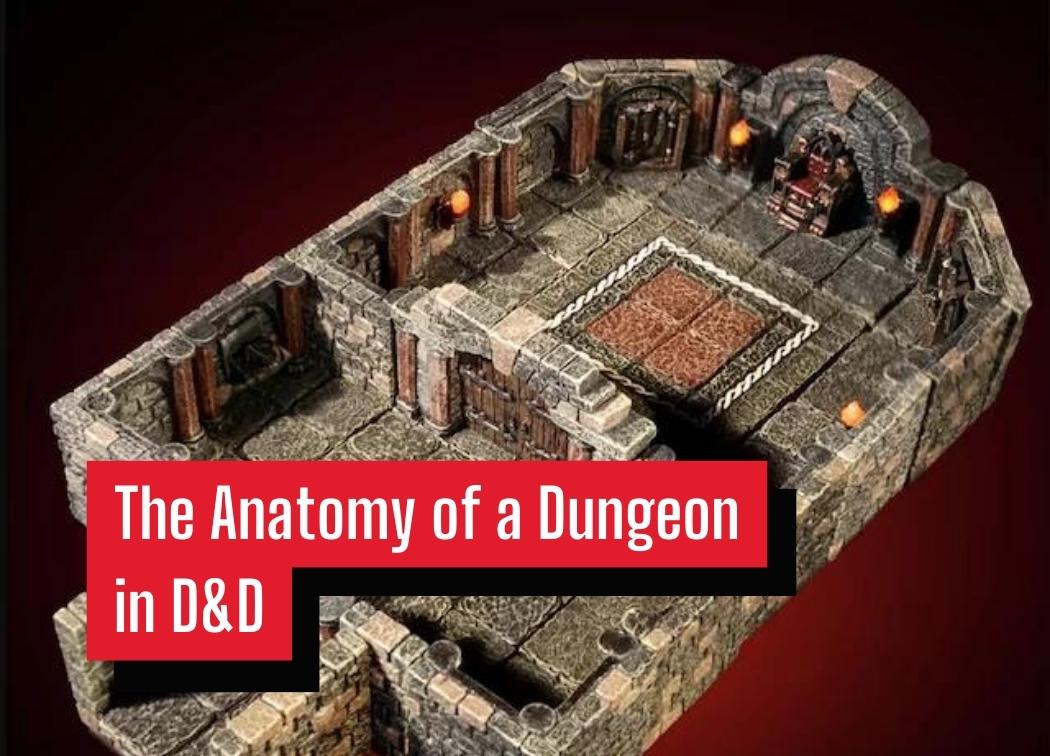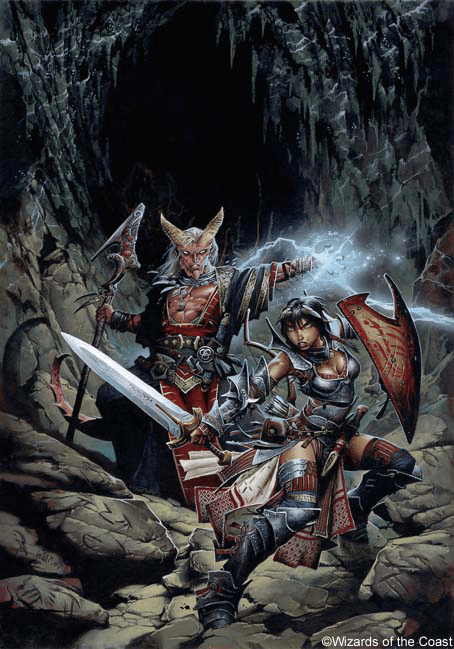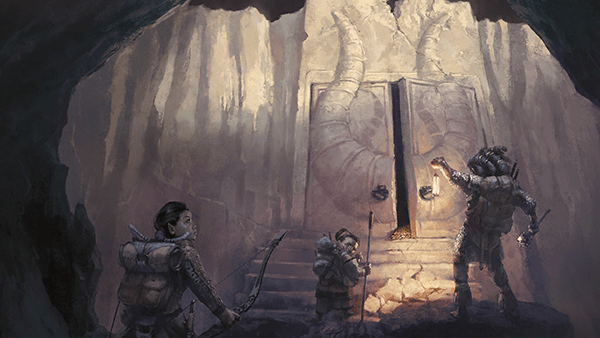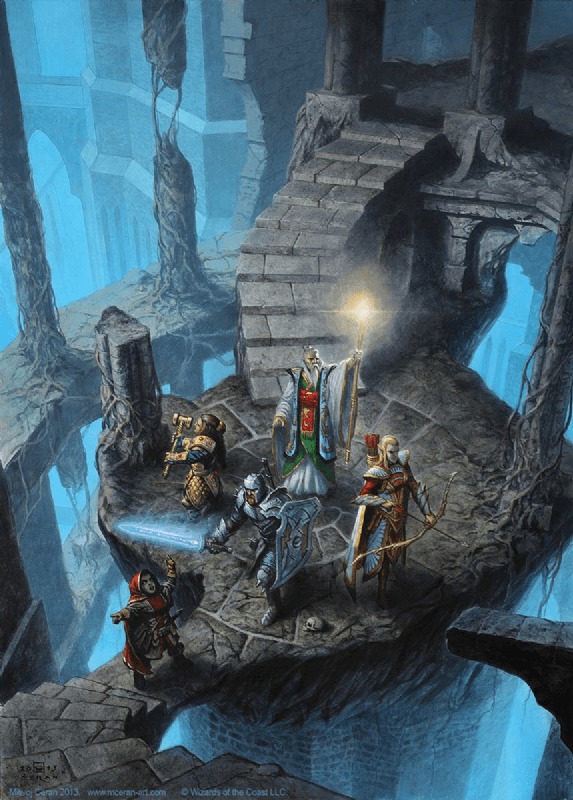The Anatomy of a Dungeon in D&D

As the name implies, Dungeons and Dragons should feature two things. Dungeons and dragons. This is a wild concept, I know. Sure, not every adventure needs to feature both or either, but at some point in your playing career you should feature both. Scratch that, explore a ton of dungeons. Delve them all!
Dungeons are a unique type of adventure and are part of what makes D&D, D&D to me. D&D 5e is no exception to this philosophy. The combat is what makes the system unique compared to the plethora of tabletop RPGs out there. Specifically, how the combat is tailor-made for exploring these infamous dungeons.
Sure, you can (and should) play all types of adventures, but dungeons are the ones I think should be featured most in any D&D game.
Let’s talk about what makes a dungeon, a dungeon, and how we can make some simple design decisions to make a seemingly-bland dungeon a unique experience. Let’s get your party hooked on dungeon delving!

The Definition of a Dungeon
A dungeon isn’t a dark cave full of monsters or a few levels of an old castle. Well, they are, but they’re not the only setting for a dungeon. Get the idea of a “setting” out of your mind when I’m talking about a dungeon in this article.
Here’s a mechanical definition of what I’m referring to when I say dungeon from here on out.
Dungeon – An enclosed space which holds multiple encounters.
That’s short, sweet, and to the point. A dungeon is not a town or village. You can run an adventure in a town or village, but it’s certainly not a dungeon since it’s an open space.
The unique aspect of a dungeon is that it’s not a place you can conveniently enter and exit on a whim. You’ll need to either cast powerful magical spells to teleport out to/from the dungeon or locate the nearest entrance/exit.
Dungeons are also notorious for forcing the players to keep track of their resources. They are not safe places to rest and recuperate your spells and features so you need to conserve them when possible and leverage your opportunities to rest when you have them.
Dungeons are fun, but they’re a unique type of adventure.
Elements of a Dungeon
Dungeons are chock-full of danger. They should be densely-packed with plenty of situations for the party to interact with. That’s a given, but let’s focus on how we get the party to and from each of those situations.
Let’s talk about the elements of the dungeon itself such as the entrances, the routes and hallways, plot hooks, and the overall theme/feel of the dungeon.
Of course, there are plenty of other elements that make up a dungeon. For example, combat encounters and traps. However, in this article, I’m more concerned with discussing the macro-scale of dungeons. We’re talking about the big picture today, but I plan on diving into the nitty-gritty in the future!
Entrances and Exits
Every dungeon should have at least two ways of entering and exiting it. Now, these don’t all have to be obvious or common knowledge, but they should exist.
Having multiple ways to enter or exit a space gives you different ways to make said entrance and exit. The path you make changes based on which exit you choose to use. In a dungeon, this means that your choice of exit will change up the path you take. This is, in essence, the goal of making a good dungeon. The dungeon can be run a multitude of different ways and still seem fresh.
I mean, a tiny dungeon can get away with having a singular entrance or exit. So can dungeons whose whole schtick is having a single entrance such as a jail or an impenetrable fortress. However, for most of the dungeons that you create, you’ll want to have multiple ways of getting into and out of the dungeon.
It has taken me a while to get to this point and I still sometimes forget to add an extra set or two of entrances or exits. However, I do believe that this is an important element in encouraging the players to explore the entirety of a dungeon.
If you add multiple ways of getting into or out of the dungeon, the players will, logically, know that they have multiple ways of escaping in a pinch. This means that they will be able to take more chances with regards to exploring rooms that are far from the main entrance or whatever entrance they arrived at. As a result, it will probably mean that the party will be less cautious and more likely to explore all of those great dungeons you create!
Adding more than one way to escape a dangerous dungeon is an easy enhancement you can make that will make an impact on how your players explore and interact with your dungeons.

Multiple Routes
Tabletop RPGs are all about having the ability to make whatever choices you desire. Even if they aren’t the most optimal choice. Especially if they are not the most optimal choice.
Giving your players multiple ways to explore is one of the most powerful ways you can give the party choices in the thick of a dungeon. This could mean that you have multiple, branching routes with unique encounters for each route, or it could mean that you sprinkle in challenges that can be ignored or quickly bypassed.
This element sort of goes hand-in-hand with having multiple entrances and exits, but it doesn’t have to be necessarily. You can have a small dungeon with a single entrance/exit that has multiple routes that the party can take.
The easiest way to accomplish this is by including optional rooms in the dungeon’s path. These rooms should still have rewards be it exp, lore, or resources, but the party can decide whether or not they wish to interact with the rooms at all. The party may decide that forgoing an optional reward is a better use of their time and resources.
Having multiple routes in a dungeon gives the party control over the situation. This is important because, from my experience, a dungeon is where the party is most vulnerable to the DM. Especially at lower-levels where the party doesn’t have access to methods of teleportation magic or other methods of escape.
Control and choice are both powerful things to have as the player. The ability to plot out a route in an unknown, dark, dungeon is giving the party both a modicum of control over the situation and the choice to engage in what they find most interesting or fun about the dungeon.
Unique Encounters or Situations
The reason why I have always loved dungeons is that they are the perfect way to play my favorite parts of TTRPGs, combat and exploration. Most dungeons that my group treks through are full of surprise encounters, multiple rooms with unique combat encounters, and random traps and encounters sprung upon the party as they explore the unknown depths of the dungeon.
From a gameplay perspective, it’s important to give your players new experiences. If every dungeon you craft is X many rooms in a succession against melee combat creatures and one big boss fight, the party is going to get bored. Dungeons shouldn’t be a single reskinned adventure, they should be exciting!
My solution to this problem is, simply put, gimmicks. I try my hardest to make every dungeon I create have some sort of gimmick. This could be the types of traps, the types of creatures used, or even a brand new mechanic or problem is thrown into the mix.
I sometimes even go the extra mile when I make a multi-level megadungeon and make each floor a brand new experience. Sort of like a dungeon within a dungeon… within a dungeon.
For example, in my latest dungeon that my party is exploring, I’ve attached a time limit to the dungeon. The party only has ~1 week to clear the dungeon, or else there will be unknown (to them) narrative consequences potentially resulting in their demise. The party has had to make some difficult choices with regards to resting or pushing forward as a result of this.
Make every dungeon different! Give the party a variety of encounters and narratives to interact with throughout your campaign.

A Primary Objective for the Party
Every dungeon should have a purpose. This is because when we design a dungeon or slap a module into our campaign we want the party to explore it. The party, on the other hand, needs a reason to risk their lives in this potentially risky enclosed space.
Therefore, whenever you create a dungeon, the most important element you need to think of is the party’s motivation. Think about what makes your party excited to go out and do a dungeon delve. That could be defeating an important boss, progressing the story via a MacGuffin, acquiring treasure, or any other reason.
The party needs to be hooked from the get-go to explore the place. It doesn’t matter how you get them invested in the dungeon, it only matters that you do.
However, the party’s objective could also simply be that “this random dungeon looks cool“. The party doesn’t have to take the bait or buy into your lore-driven objective to be hooked into exploring a dungeon. After all, the only thing that matters is that the party explores the dungeon you worked so hard to build!
Conclusions
I hope that this article helps with articulating some of what I believe to be the most parts of designing a dungeon. As I said before, these are the higher-level elements of dungeon design so it’s more of a top-down type of view on creating a dungeon.
Start with these elements and how you want your dungeon to look and feel. Then think about the rooms within the dungeon. Finally, add your creatures, traps, and other encounters and voila, your dungeon is finished!
As you design and create more dungeons you’ll think about these elements less. Not because they’re not important, but because they’re so important that they become second-nature for your design.
Simple changes such as adding multiple entrances and exits or adding a few optional rooms can change a boring dungeon into a fun multi-delve experience where the party keeps coming back for more.
